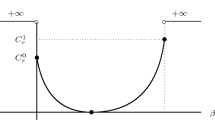Abstract
Many real-world networks exhibit the phenomenon of edge clustering,which is typically measured by the average clustering coefficient. Recently,an alternative measure, the average closure coefficient, is proposed to quantify local clustering. It is shown that the average closure coefficient possesses a number of useful properties and can capture complementary information missed by the classical average clustering coefficient. In this paper, we study the asymptotic distribution of the average closure coefficient of a heterogeneous Erdős–Rényi random graph. We prove that the standardized average closure coefficient converges in distribution to the standard normal distribution. In the Erdős–Rényi random graph,the variance of the average closure coefficient exhibits the same phase transition phenomenon as the average clustering coefficient.
Similar content being viewed by others
References
A. Barrat and M. Weigt, On the properties of small-world network models, Eur. Phys. J. B, 13 (2000), 547–560.
A. L. Barabási and Z. Oltvai, Network biology: understanding the cell’s functional organization, Nat. Rev. Genet., 5 (2004), 101-–113.
D. Borsboom, M. K. Deserno, M. Rhemtulla, et al., Network analysis of multivariate data in psychological science, Nat. Rev. Methods Primers, 1 (2021), 58.
G. Bianconi and M. Marsili, Number of cliques in random scale-free network ensembles, Physica D: Nonlinear Phenomena, 224 (2006), 1–6.
G. J. C. Becq, E. L. Barbier and S. Achard, Brain networks of rats under anesthesia using resting-state fMRI: comparison with dead rats, random noise and generative models of networks, J. Neural Eng., 17 (2020), 045012.
L. Cao, L. Li, Z. Huang, F. Xia, F., R. Huang, Y. Ma and Z. Ren, Functional network segregation is associated with higher functional connectivity in endurance runners, Neuroscience Letters, 812 (2023), 137401.
C.F. Chiasserini, M. Garetto and E. Leonardi, Social network de-anonymization under scale-free user relations, IEEE/ACM Trans. Networking, 24 (2016), 3756–3769.
A. Chakrabarty, S. R. Hazra, F. D. Hollander and M. Sfragara, Large deviation principle for the maximal eigenvalue of inhomogeneous Erdős–Rényi random graphs, J. Theoret. Probab., 35 (2022), 2413–2441.
E. M. Jin, M. Girvan, and M. E. J. Newman, Structure of growing social networks, Phys. Review E, 64 (2001), 046132.
M. Newman, The structure and function of complex networks, SIAM Review, 45 (2003), 167–256
A. J. O’Malley and P. V. Marsden, The analysis of social networks, Health Serv. Outcomes Res. Method., 8 (2008), 222–269.
U. A. Tooley, A. T. Park, J. A. Leonard, A. L. Boroshok, C. L. McDermott, M. D. Tisdall and A. P. Mackey, The age of reason: functional brain network development during childhood, J. Neuroscience, 42 (2022), 8237-8251.
D. J. Watts and S. H. Strogatz, Collective dynamics of ‘small-world’ networks, Nature, 393 (1998), 440–442.
H. Yin, A. Benson, and J. Leskovec, The local closure coefficient: a new perspective on network clustering, WSDM’19, (2019), 303–311.
M. Yuan, On the Randić index and its variants of network data, TEST (2023), https://doi.org/10.1007/s11749-023-00887-6.
M. Yuan, Asymptotic distribution of degree-based topological indices, MATCH Commun. Math. Comput. Chem., 91 (2024), 135–196.
M. Yuan, On the R´enyi index of random graphs, Stat. Papers, (2023), https://doi.org/10.1007/s00362-023-01463-8.
M. Yuan and X. Zhao, Asymptotic distributions of the average clustering coefficient and its variant, arXiv:2311.10979 (2023).
X. Zhao and M. Yuan, Robustness of clustering coefficients, Comm. Stat. Theory Methods (2023), https://doi.org/10.1080/03610926.2023.2259525.
Acknowledgements
The author thanks the anonymous referees for valuable comments.
Author information
Authors and Affiliations
Corresponding author
Rights and permissions
Springer Nature or its licensor (e.g. a society or other partner) holds exclusive rights to this article under a publishing agreement with the author(s) or other rightsholder(s); author self-archiving of the accepted manuscript version of this article is solely governed by the terms of such publishing agreement and applicable law.
About this article
Cite this article
Yuan, M. Central limit theorem for the average closure coefficient. Acta Math. Hungar. (2024). https://doi.org/10.1007/s10474-024-01416-z
Received:
Revised:
Accepted:
Published:
DOI: https://doi.org/10.1007/s10474-024-01416-z




